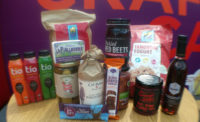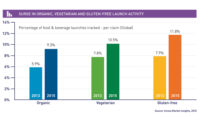TECH FLASH
‘Guru’ predicts top food trends of 2015
The growth of online grocery shopping and preferences for craft foods, fermented foods and smoked flavors make next year’s list

In 2014, food processors and manufacturers took advantage of food trends such as added protein and gluten free. As the industry constantly evolves, so will these trends, which mean there is no time to sleep on what consumers will demand in 2015.
But what will next year bring?
To answer that question, ConAgra Foods, Inc. worked closely with consumer trend analyst Phil Lempert to devise a list of the most significant changes in food trends.
Known as the Supermarket Guru, Lempert is an author and speaker who provides guidance to customers and business leaders on upcoming corporate and consumer trends.
According to Lempert, the biggest changes will stem from a desire for bold-flavored foods that also offer health benefits, as well as shifts in consumers’ approach to supermarket shopping—both online and at brick-and-mortar stores. Other trends tend to reflect the eating behaviors among Generation Z and the Baby Boomers.
“The top food trends for 2015 indicate people’s palates are continuing to evolve, and they are gravitating toward streamlined grocery shopping experiences that are convenient for their lifestyles,” says Lempert. “In 2015, look for brands and merchants to advance their product offerings and shopping amenities to meet these demands.”
Lempert’s top eight food trends to look for in 2015 include:
1. Grazing Golden-Agers: Research shows snacking among consumers over the age of 65 could contribute to additional years with a higher quality of life. Lempert says more Boomers—those raised in the “three square meals a day” era—will employ a “grazing” approach to eating next year, focusing on foods rich in nutrients like protein, fiber and Omega3s. Other snacks include whole grains and seeds.
2. Same-Day Delivery Not Just for City Clickers: Lempert says revenue gains among food and beverage e-commerce/delivery service indicate the trend will expand to mainstream consumers living in both urban and rural areas next year. Products will evolve and become catered to online shoppers. More brands will bundle multiple SKUs to create meal kits or offer pre-packaged sets of multiple products.
3. Everything Smoked: Demand for smoked foods has risen as Lempert says chefs begin to apply smoking and grilling to impart new flavor to other proteins and alternatives like vegetables, butters and even cocktails. And, with smokers gaining in popularity in backyards across America, at-home cooks are also experimenting with smoking non-traditional foods.
4. The Rise of Fermented Foods: Foods like yogurt, tempeh and sauerkraut will be featured in 2015. These foods contain live cultures or are preserved in liquid so their sugars and starches can become bacteria-boosting agents. After multi-year growth of gluten-free foods and probiotics, many consumers have found their digestive health has improved. According to Lempert, in 2014, gluten free expanded beyond the 1 percent of the population that has Celiac disease. He says this will continue and also evolve into an increased focus on the consumption of fermented foods as people continue to look for ways to aid digestion.
5. Gen Z: Chefs Everyday: Generation Z’s (born after 1995) collective attitude toward food is simplicity and health, Lempert says. They tend to use stove tops rather than microwaves for cooking meals and fresh ingredients to prepared foods.
6. Craft Foods Make Their Way Into Kitchens Everywhere: Typically, craft foods are thought of as foods made in small batches with specialized local ingredients, but major companies are finding ways to produce them in larger quantities. For instance, the phenomenon of craft beer brought new excitement, flavors and sales to the struggling beer industry. In 2015, Lempert says this trend will extend to other beverages and food, as Millennials in particular continue to seek unique tastes and foods with authentic origin stories.
7. Nutrition Labels: No Longer Just on Packaged Foods: Since consumers want more information about their foods, innovative devices will look to offer this information instantaneously. Information about a food’s ingredients, chemical makeup or nutritional values will become more readily available and commonplace in the supermarket and our kitchens, Lempert says.
8. Supermarkets Convert Into Socializing Spaces: Supermarkets have evolved from straightforward centers where consumers could buy groceries to purveyors of lifestyle. Present-day supermarkets are developing a variety of services that help set them apart and establish each outlet as an ambassador of niche lifestyle trends. In the near future, Lempert says, consumers can anticipate more specialization to present them with a unique experience that showcases their personality and philosophy toward foods—instead of stores presenting themselves solely as vendors of goods.
More information can be found by visiting www.forkful.com.
Looking for a reprint of this article?
From high-res PDFs to custom plaques, order your copy today!







